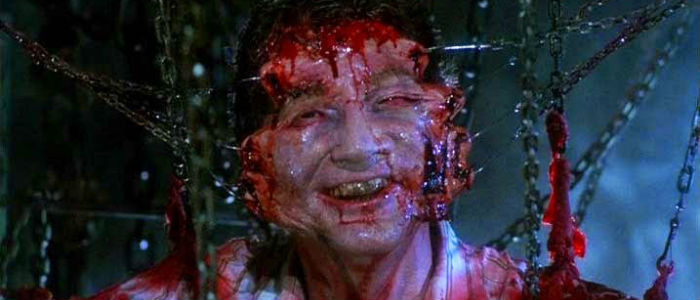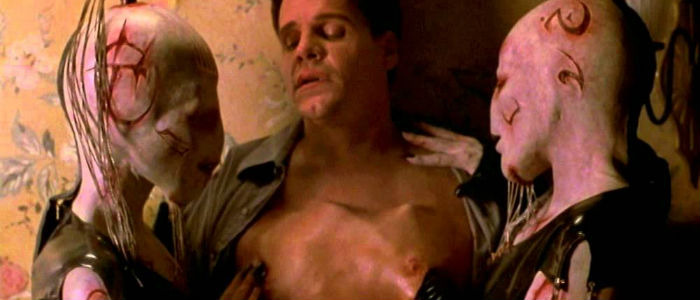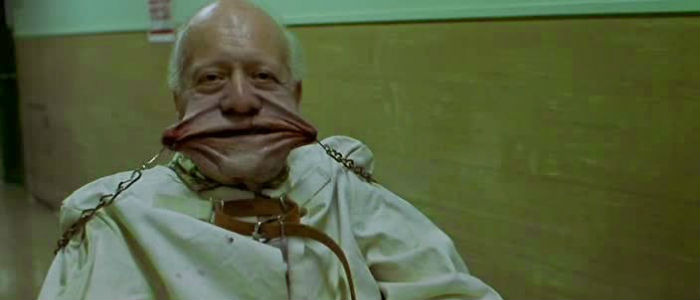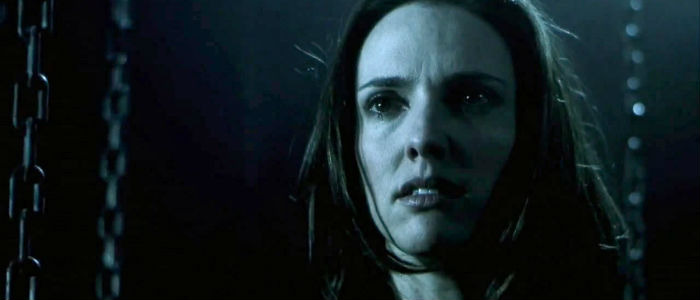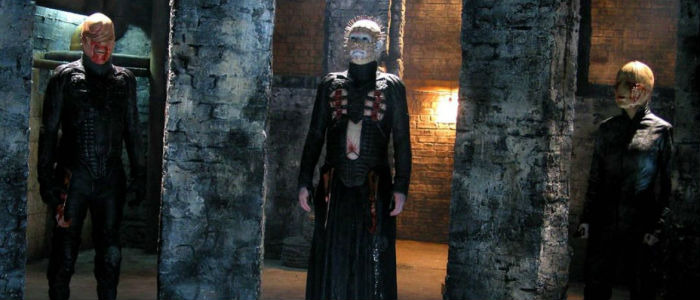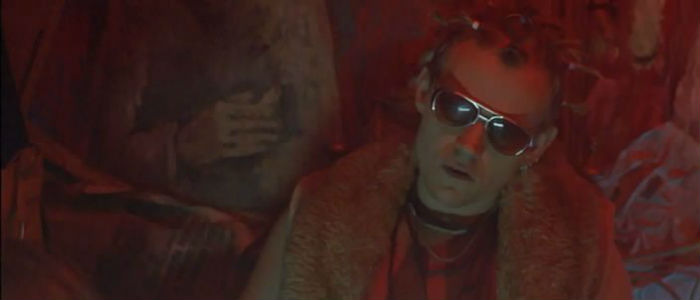Seeking Pleasure In The Painful Direct-To-Video 'Hellraiser' Sequels [Part 1]
(Welcome to DTV Descent, a series that explores the weird and wild world of direct-to-video sequels to theatrically released movies. In this edition, we travel deep into the bowels of hell for the first three – of six! – DTV sequels to Clive Barker's Hellraiser.)
"I have seen the future of horror, and his name is Clive Barker," said Stephen King about the young Brit's six-volume collection of horror tales, Books of Blood, and Barker never looked back. More stories and novels followed, and he quickly found himself offered the directorial reins adapting one of his own novellas, "The Hellbound Heart." The budget was low, but Barker's imagination and audacity were limitless, making Hellraiser (1987) a blast of S&M-tinged horror the likes of which we had never really seen before. Demons in bondage gear and body piercings, a lusty woman willing to kill for her undead lover, a homeless dude at the end who I spent years thinking was Barker in a cameo role... Limited filmmaking experience and budgetary restrictions be damned! Barker crafted something truly memorable here.
Barker created multiple monsters with the film, but his most eternal creation appears to have been the franchise itself. Nine sequels followed, and while the first two were pretty good and the third also played theatrically, the next six went deservedly straight to DVD. Well, I say deservedly, but I had never actually watched them.
Until now! So join me, won't you, as I foolishly subject myself to the first three DTV sequels with increasingly stupid titles – Hellraiser: Inferno, Hellraiser: Hellseeker, and Hellraiser: Deader.
The Beginning
Hellraiser is the tale of a love triangle between a boy, a girl, and a box. Larry is hoping his new wife Julia will last longer than his first marriage, but what he doesn't know is that she's been boning his brother Frank on the side. That ended when Frank went missing, but it turns out he died at the hands of demons answering his call for pain, pleasure, and the sticky divide in-between. Blood and other juices hit the floor, bringing Frank back to life, and soon Julia's bringing him fresh meat to suck dry in the hopes of becoming fully human once more. They would have gotten away with it too, if it weren't for Larry's spunky daughter Kirsty who knows an evil stepmother when she sees one and never liked pervy Uncle Frank either. With the Lament Configuration in hand, she sends all her skeezy relatives straight to hell, but can she escape the demons' grasp too?Hellbound: Hellraiser II (1988) sees poor Kirsty in a mental hospital trying to convince people that the leather-clad demons are real, but before she can explain where she found time to get a fabulous new perm, the institution's head doctor takes an interest in her case. He's been searching for some hellish pleasures too, it seems, and with the help of a puzzle-obsessed mute and a bloody mattress, he's found the doorway he's been looking for. The demons return and Kirsty's once again left to close the door to the sexy geometry camp that is Leviathan's hell.Hellraiser III: Hell on Earth (1992) gives Kirsty a break and finds a new hero in intrepid female reporter Joey, who witnesses a strange death involving chains, hooks, and an exploding body. Pinhead was Han Solo'd into a pillar at the end of the last film after discovering he was once human, and now his two halves have split. The monstrous half is trying to bring hell to Earth, and the only chance humanity has is the combined forces of Joey and Pinhead's pre-demonized self.
Meanwhile, Hellraiser: Bloodline (1996) opens on a spaceship.
The DTV Plot
Hellraiser: Inferno (2000): "One day my life would become the most challenging puzzle of all," says dirty cop Joseph Thorne, and that's how you know you're in a DTV Hellraiser movie. Thorne's a bit of a prick, and he proves it frequently by stealing evidence, cheating on his wife, and doing street magic. A visit to a murder scene lands the Lament Configuration in his lap, and when he opens it – he's so good at puzzles you guys! – he's visited by Pinhead, a much shorter Chatterer (called Torso here), and two pervy freaks who lick him and physically reach into his skin. Were they merely a dream because he's actually in hell? Sure, why not. Thorne's too busy to worry about it as a serial killer is carving up victims and leaving a child's fingers at the crime scene. Did I mention the victims all have some connection to Thorne? Ruh roh!99 minutes is a long way to go for a poor man's Angel Heart. It's clear early on that Thorne is the killer, and when he starts meeting with a bearded psychiatrist, it's only a matter of time before the hairy wise man is revealed to be Robert De Niro, the devil, or Pinhead himself. Worse, rather than tell an intriguing mystery with a protagonist we care about, we're stuck in a "dream" with a guy we're happy to see tortured. Thorne isn't cool, antihero bad – he's just dickhole bad, and having the mystery revolve around his interior struggle between assholery and innocence doesn't quite jive with the Hellraiser mantra. Since when does Pinhead care about teaching life lessons? Excessive, on-the-nose narration doesn't help either, and while the film deserves kudos for falling closest to the original in regard to limited cenobite screentime, the choice to fill the film with faceless hallucinations passing through Thorne's daily life just leaves us wanting to watch Jacob's Ladder again instead. Of course, on the other hand, we do get to see two cowboys display some mad martial arts skills.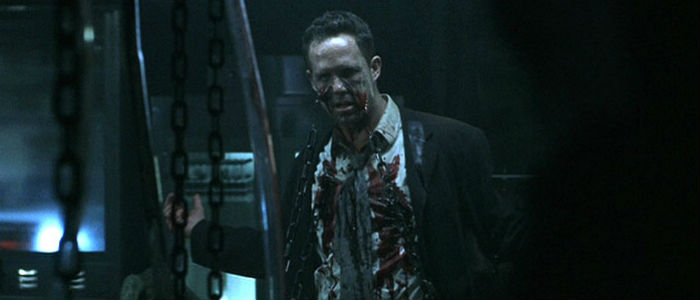 Hellraiser: Hellseeker (2002): Trevor's a bit of a prick, and if you've seen the previous film, you already know where this is going. After his wife Kirsty – yes that Kirsty – dies in a car accident that also left him with amnesia, he struggles to understand just what's happening. He's seeing crazy things, all the women in his life want to diddle him, and the puzzle box he found seems to attract the attention of some pretty uptight folks in leather. Is it all a dream because he's actually in hell? Sure, why not.Kirsty's back! Aaand she's dead. Fine, this isn't killing off Alice Hardy at the start of Friday the 13th Part 2-level obnoxious, but it's still not cool. It's an especially poor choice when you realize the premise of the film ultimately comes down to Pinhead and friends trying to ensnare Kirsty for good this time. She's the goal, yet she's also a supporting player given minimum screentime? Who willingly opened the box again?! For shame. Lucky for her, she still knows how to cut a mean deal, and in exchange for her own life she delivers five other souls instead, including her unfaithful, murderous hubby. As with Inferno, the film keeps Pinhead's involvement to a minimum, but rather than it being out of respect for the original, it's clearly due to budgetary concerns and/or the script's possible origin as a non-Hellraiser story. Because seriously, a character wanting to off his wife is one thing, but trying to do so via the devil's Rubik's Cube is just poor planning.
Hellraiser: Hellseeker (2002): Trevor's a bit of a prick, and if you've seen the previous film, you already know where this is going. After his wife Kirsty – yes that Kirsty – dies in a car accident that also left him with amnesia, he struggles to understand just what's happening. He's seeing crazy things, all the women in his life want to diddle him, and the puzzle box he found seems to attract the attention of some pretty uptight folks in leather. Is it all a dream because he's actually in hell? Sure, why not.Kirsty's back! Aaand she's dead. Fine, this isn't killing off Alice Hardy at the start of Friday the 13th Part 2-level obnoxious, but it's still not cool. It's an especially poor choice when you realize the premise of the film ultimately comes down to Pinhead and friends trying to ensnare Kirsty for good this time. She's the goal, yet she's also a supporting player given minimum screentime? Who willingly opened the box again?! For shame. Lucky for her, she still knows how to cut a mean deal, and in exchange for her own life she delivers five other souls instead, including her unfaithful, murderous hubby. As with Inferno, the film keeps Pinhead's involvement to a minimum, but rather than it being out of respect for the original, it's clearly due to budgetary concerns and/or the script's possible origin as a non-Hellraiser story. Because seriously, a character wanting to off his wife is one thing, but trying to do so via the devil's Rubik's Cube is just poor planning.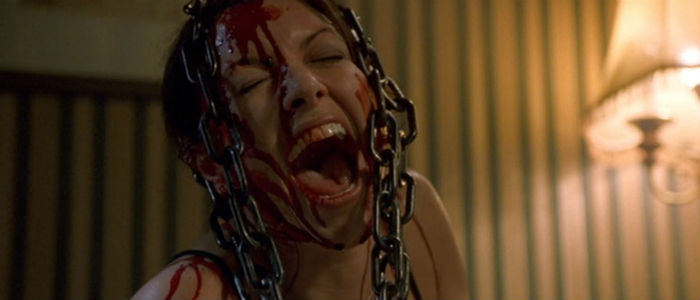 Hellraiser: Deader (2005): Reporter Amy Klein is a bit of a prick. Okay, maybe that's a bit harsh, but she's definitely morally flexible in her pursuit of sensational stories. She heads to Hungary on assignment to investigate a supposed cult that just might be resurrecting the dead, but the truth is far more convoluted. The cult's leader is a descendant of the man who built the original box, and now he wants a piece of the action. The best route to achieving his dreams? Killing and resurrecting unstable twenty-somethings until Pinhead deigns to show his prickly face. I guess?There are only two things worse than this title – the realization that this is a Stan Winston Production and the premise. It's logically flawed as our girl Kirsty has been opening and closing the box for years without a triggering incident predating her mad skills, but even more offensive is the idea that only people who've been severely victimized in life can open the doorway to hell. The implication is probably the ugliest thing in this entire franchise (although to be fair, I still haven't seen the next three sequels). As with the previous two films, it's also extremely heavy on hallucinations, and in weak hands, that's just lazy.
Hellraiser: Deader (2005): Reporter Amy Klein is a bit of a prick. Okay, maybe that's a bit harsh, but she's definitely morally flexible in her pursuit of sensational stories. She heads to Hungary on assignment to investigate a supposed cult that just might be resurrecting the dead, but the truth is far more convoluted. The cult's leader is a descendant of the man who built the original box, and now he wants a piece of the action. The best route to achieving his dreams? Killing and resurrecting unstable twenty-somethings until Pinhead deigns to show his prickly face. I guess?There are only two things worse than this title – the realization that this is a Stan Winston Production and the premise. It's logically flawed as our girl Kirsty has been opening and closing the box for years without a triggering incident predating her mad skills, but even more offensive is the idea that only people who've been severely victimized in life can open the doorway to hell. The implication is probably the ugliest thing in this entire franchise (although to be fair, I still haven't seen the next three sequels). As with the previous two films, it's also extremely heavy on hallucinations, and in weak hands, that's just lazy.
Talent Shift
This section of the column is typically a pretty clear indicator of where sequels go wrong, but in the case of the Hellraiser franchise, the level of talent has stayed fairly... level. Of course, this assessment also depends on your definition of "talent." Barker had directed stage productions and a pair of shorts, but Hellraiser was his first feature film as director. It wasn't his first feature script, though. And while I will piss on a priest in my defense of Rawhead Rex (1986), I have no such positivity to spare for Underworld (1985, AKA Transmutations). And to be fair, my love of the former has little to do with the script. Add a cast that includes the great Andrew Robinson, Clare Higgins, and newcomers Doug Bradley and Ashley Laurence, and you have a horror film in Hellraiser that has stood tall for over 30 years.The three theatrical sequels that followed were all directed by varying talents from the horror field, including Hellbound: Hellraiser II's Tony Randel (Ticks, 1993), Hellraiser III: Hell on Earth's Anthony Hickox (Waxwork, 1988), and Hellraiser: Bloodline's Kevin Yagher (he designed and built Chucky from Child's Play!), and written by Barker and/or novelist Peter Atkins (Morningstar). They weren't big names necessarily, but they were known quantities.With only a singular exception, these first three DTV sequels flip that scenario with a lack of anyone of note offscreen. The exception, of course, is Scott Derrickson who directed and co-wrote Hellraiser: Inferno. He's since blossomed into a marvelous filmmaker, but the other writers/directors...have not. The actors fare slightly better with more recognizable faces including Craig Sheffer (Nightbreed, 1990), James Remar (Tales from the Darkside: The Movie, 1990), Dean Winters (Allstate Insurance commercials), and Kari Wuhrer (Thinner, 1996). Look, I said slightly better.
How the Sequels Respect the Originals
Pinhead is the obvious thread tying all of the films together, and the DTV sequels bring him back as a groovy sadist without all the backstory regarding his human origins. They also maintain the themes of intertwined violence and sex in pursuit of the idea that pain is pleasure. I get it, hot wax drippings and nipple clamps are the bees knees, but am I wrong in thinking none of these people being torn to shreds, twisted into pretzels, and reminded of their childhood assaults are actually enjoying this? Maybe I'm just out of touch. One of the films also brings Kirsty back, and that's never a bad thing despite her being shortchanged in screentime.
How the Sequels Shit on the Originals
Right off the bat, these are pretty bad movies. Beyond the obvious, though, they also betray Barker's original few films in two notable ways. For one, we're rarely given an innocent protagonist to root for like we had with Kirsty, the mute teen, or the journalist. Inferno and Hellseeker in particular saddle viewers with a couple of chodes whose descent into hell is well deserved, meaning there's no suspense or struggle as we're completely fine with them being there. Deader – ugh, that title! – goes the opposite route in trying to force sympathy by giving us a lead character traumatized by childhood sexual assault...before suggesting that the trauma means she's gifted in opening devil boxes, implying a bond to her molester-father through mirrored editing of their demises, and then stating quite clearly that her only escape from this suffering is through suicide. Go straight to hell, Deader.
The other issue, touched upon briefly above, is the endless series of dream sequences, hallucinations, and illusions littering these three movies. The "twist" endings of the first two amount to little more than hack-worthy stabs at feature-length Twilight Zone episodes and even the third film spends far too much time away from "reality." Viewers need some manner of grounding for a film to take hold, and if it's not in the events or story then it needs to be in the characters. Their ubiquitous presence once again means nothing happening here is "real" or tangible, and while that can work in the hands of a strong filmmaker (Vanilla Sky, Jacob's Ladder), it's just one long fart noise across these three movies.
Conclusion
My suffering is legendary. I still don't fully understand the appeal of that pain and how it translates to pleasure, but I wouldn't have been given this assignment if there wasn't some kind of reward coming my way right? All this suffering must be in the service of something glorious, but maybe it's waiting for me in the next three Hellraiser films? Maybe the sweet release eluding me across these last several hours is sitting like a puzzle box-shaped Holy Grail in Hellraiser: Hellworld, Hellraiser: Revelations, or Hellraiser: Judgment? My journey towards the ultimate pleasures continues...

